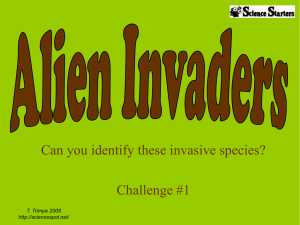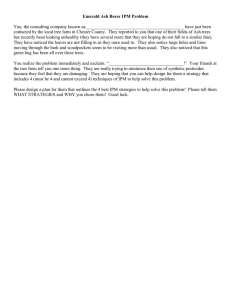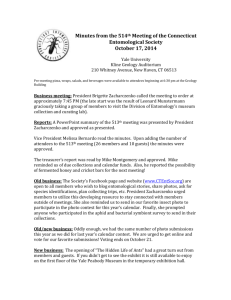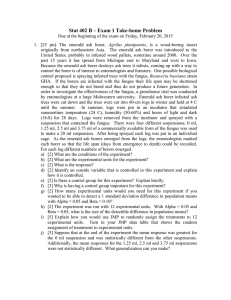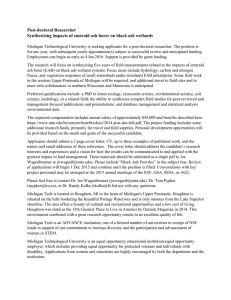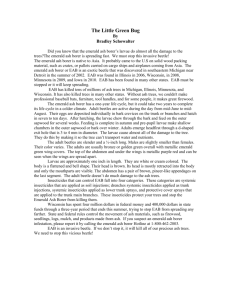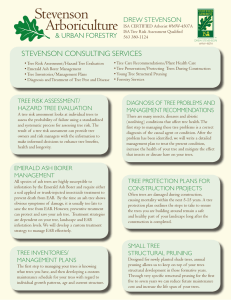EMERALD ASH BORER – INFESTATION UPDATE
advertisement
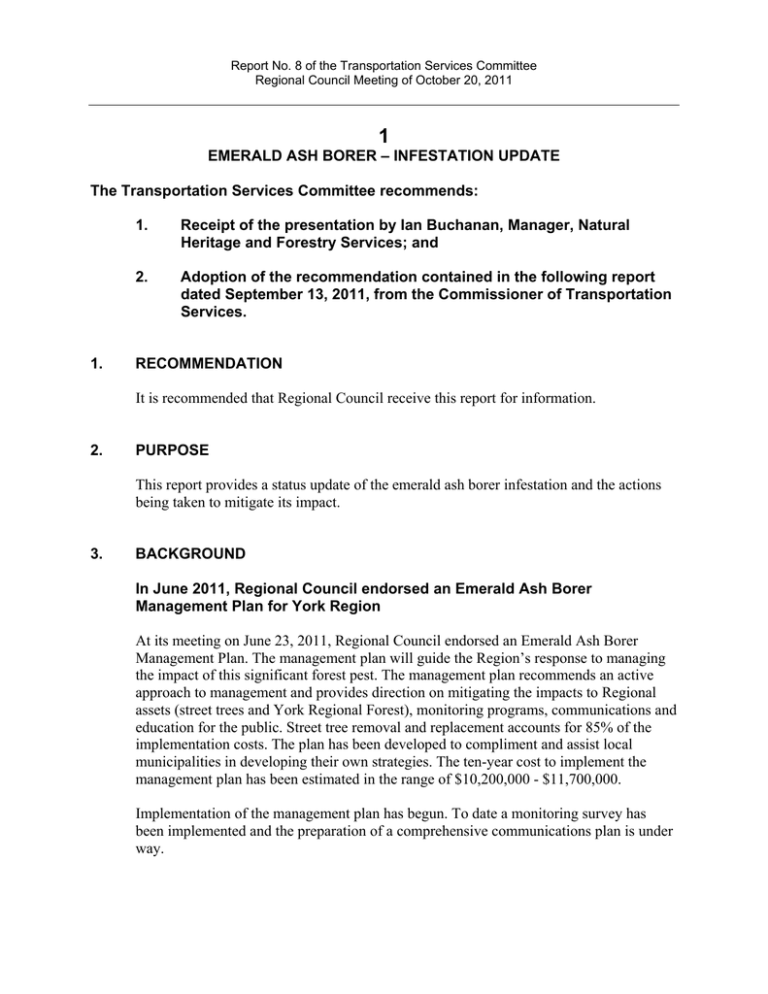
Report No. 8 of the Transportation Services Committee Regional Council Meeting of October 20, 2011 1 EMERALD ASH BORER – INFESTATION UPDATE The Transportation Services Committee recommends: 1. 1. Receipt of the presentation by Ian Buchanan, Manager, Natural Heritage and Forestry Services; and 2. Adoption of the recommendation contained in the following report dated September 13, 2011, from the Commissioner of Transportation Services. RECOMMENDATION It is recommended that Regional Council receive this report for information. 2. PURPOSE This report provides a status update of the emerald ash borer infestation and the actions being taken to mitigate its impact. 3. BACKGROUND In June 2011, Regional Council endorsed an Emerald Ash Borer Management Plan for York Region At its meeting on June 23, 2011, Regional Council endorsed an Emerald Ash Borer Management Plan. The management plan will guide the Region’s response to managing the impact of this significant forest pest. The management plan recommends an active approach to management and provides direction on mitigating the impacts to Regional assets (street trees and York Regional Forest), monitoring programs, communications and education for the public. Street tree removal and replacement accounts for 85% of the implementation costs. The plan has been developed to compliment and assist local municipalities in developing their own strategies. The ten-year cost to implement the management plan has been estimated in the range of $10,200,000 - $11,700,000. Implementation of the management plan has begun. To date a monitoring survey has been implemented and the preparation of a comprehensive communications plan is under way. Report No. 8 of the Transportation Services Committee Regional Council Meeting of October 20, 2011 To facilitate collaboration between Federal, Provincial and local governments, a York Region Emerald Ash Borer Technical Working Group has been established An Emerald Ash Borer Technical Working Group has been formed with staff from the Region, local municipalities, conservation authorities, and the Provincial and Federal governments. Through the technical working group survey efforts have been harmonized, communication materials with consistent messaging developed and best practices shared. 4. ANALYSIS AND OPTIONS The 2011 Emerald Ash Borer survey has confirmed significant infestations throughout the Towns of Markham Richmond Hill and WhitchurchStouffville, and the City of Vaughan An emerald ash borer monitoring survey was conducted in portions of York Region in 2011 to confirm the extent of the infestations. Approximately 175 green prism monitoring traps were installed in the City of Vaughan and the Towns of Richmond Hill, Markham and Whitchurch-Stouffville, and the Township of King. In addition, 16 traps were installed in the Towns of Aurora and Newmarket. The results of the survey confirm the infestation has spread to the north portions of Vaughan, Richmond Hill, Whitchurch-Stouffville and Markham. In addition an infestation has been confirmed in the southern portion of Aurora (Attachment 1). The monitoring survey will be continued in 2012 to track the spread of the emerald ash borer. The 2012 survey will focus on the Township of King and Towns of Aurora, Newmarket and Whitchurch-Stouffville. Survey traps will also be installed in the Towns of East Gwillimbury and Georgina. The Towns of Richmond Hill and Markham, and the City of Vaughan estimate 6,000 ash trees will be removed over the next two to three years Several local municipalities are following the Region’s lead and are developing emerald ash borer management plans. While no plans have been officially adopted, they will take a management approach similar to the Region’s. Several municipalities are reviewing the use of pesticides to protect high-value ash trees in an effort to mitigate the impact of the emerald ash borer. Significant tree decline and death is expected to occur over the next several years in southern York Region. The City of Vaughan has begun to remove trees killed by the emerald ash borer. Region street trees have begun to decline in Vaughan and street tree removal and replacement will be required in 2012. A similar situation is expected to occur in the Towns of Richmond Hill and Markham in the next several years. Report No. 8 of the Transportation Services Committee Regional Council Meeting of October 20, 2011 A Residents Guide is being developed to assist residents impacted by the infestation The Region has an estimated 2,800,000 ash trees. The majority of these trees are located on private lands. As these trees succumb to the emerald ash borer, the impact on residents will be significant. The Region’s emerald ash borer management plan has identified measures to assist residents and help mitigate the impact. To assist residents with the impact, the Region, in partnership with local municipalities, has developed a Residents Guide to Managing the Emerald Ash Borer Draft (Attachment 2). This guide contains a variety of information on the management of the emerald ash borer including: • • • • • • General information on the emerald ash borer How to identify ash trees Signs and symptoms of an infested tree Options for managing the emerald ash borer General information on obtaining the services of a qualified tree care company Local municipal emerald ash borer web page addresses As the infestation grows and trees begin to die, we expect an increase in resident inquires. The residents guide will be available for distribution in early 2012. A more detailed information package will be distributed to elected officials and their staff to assist with resident inquiries in the spring of 2012. Federal and Provincial governments have responded to correspondence sent by the Clerks Office requesting financial assistance At its meeting on April 21, 2011, Regional Council directed the Clerks Office to circulate correspondence to the Federal and Provincial governments requesting financial support for the management of the emerald ash borer. The Region has received responses from the Federal Ministers of Environment and Natural Resources, and the Premier of Ontario (Attachment 3). The correspondence received did not provide a commitment to financial support for the management of the emerald ash borer. The Region will continue to seek financial support from the Federal and Provincial authorities for management of this significant forest pest. Report No. 8 of the Transportation Services Committee Regional Council Meeting of October 20, 2011 5. FINANCIAL IMPLICATIONS Management of the Emerald Ash Borer will cost the Region an estimated $10,200,000 to $11,700,000 over the next ten years The spread of emerald ash borer across York Region will have significant financial implications to the Region. The principle costs (85%) associated with the impact of the emerald ash borer are related to the removal of the dead ash trees and their replacement. Funding will be required to support the overall management, communications, monitoring, tree removal, tree replacement and tree protection. Implementation of the Emerald Ash Borer Management Plan will require an estimated $10,200,000 to $11,700,000 over the next ten years. For 2012, $250,000 in funding is required for survey, communication, tree removal and tree replacement activities. This funding requirement has been identified through the 2012 budget process and is subject to Regional Council approval. 6. LOCAL MUNICIPAL IMPACT The management of emerald ash borer will affect all municipalities in York Region. As the infestation spreads, it is anticipated that the City of Vaughan, Town of Markham and the Town of Richmond Hill will represent the initial line of activity. It is expected the costs associated with management of the emerald ash borer in the local municipalities will be significant. The magnitude of cost will depend on the proportion of ash trees, the rate of death and decline, and the extent of local tree protection and replacement strategies. Regional staff will continue work very closely with local counterparts through the Technical Working Group to share best practices and develop operational efficiencies to combat this threat. The Region will continue its monitoring survey to track the spread of the insect throughout the Region. 7. CONCLUSION The 2011 emerald ash borer survey has confirmed that significant portions of Vaughan, Richmond Hill and Markham have been infested. The pest has continued to spread north infesting an area in southern Aurora. Local municipalities and the Region expect street tree removal and replacement to be required in 2012. Coordination of Regional and local municipal actions through the Technical Working Group will ensure the delivery of a coordinated and cost effective response to the infestation. The Region should continue to press the Federal and Provincial authorities for financial support to manage this forest pest. Report No. 8 of the Transportation Services Committee Regional Council Meeting of October 20, 2011 For more information on this report, please contact Ian D. Buchanan at Ext 5204. The Senior Management Group has reviewed this report. (The three attachments referred to in this clause are attached to this report.) COUNCIL REPORT ATTACHMENT 1 COUNCIL REPORT ATTACHMENT 2 A Resident’s Guide to Dealing with the Emerald Ash Borer in York Region Front: Image of Tree, insect Inside: Emerald Ash Borer What is the Emerald Ash Borer? The Emerald Ash Borer (EAB) is a metallic green-colour beatle originating from Asia that kills all ash trees (not including Mountain Ash). Once established, EAB has proven impossible to control. (include pic of Ash Tree). The insect is apreading across North America and was discovered in York Region in 2008. While the Emerald Ash Borer poses no risk to human health, it is a significant threat to our trees and forests. Ash trees can be distinguished from other trees by there leaves (image here), buds (image) and bark (image here). Signs and symptoms of EAB infestation include: thinning tops of tees, shoots or stems from the main stem, small D shaped holes made by the beetles (images here), cracking bark and woodpecker damage (images here). What is York Region Doing? York Region is working co-operatively with the Canadian Food Inspection Agency, the Ministry of Natural Resources, conservation authorities and local municipalities to share best practices, monitor the spread, determine the best course of action to manage its impact. The Region has a management plan that includes monitoring surveys, replanting and collaboration with regulatory organizations and local municipalities. We are removing dying ash trees along our road network and replacing trees with other kinds. In the York Regional Forest we are removing hazardous trees and monitoring the change in the forest. To help control the spread of the Emerald Ash Borer, the Canadian Food Inspection Agency has placed restrictions on the movement of all firewood and ash tree materials beyond areas of known infestations (Regulated Area e.g. north of York Region). The spread of the insect is often accelerated through the movement of infested firewood, nursery stock and forest products. How can I protect my Ash tree? Non-infested trees and trees with low levels of infestation can be protected with a bioinsecticides treatment. TreeAzin is the only product currently registered in Canada proven to be effective in controlling EAB. This treatment needs to be done every two years, from May through August. Other factors affecting dead tree removal cost include urgency, access, potential conflicts with utilities/structures, complete or partial wood removal, time of the year and stage of decay. For more information about TreeAzin visit www.treeazin.com. Homeowners who wish to consider using TreeAzin should refer to the www.bioforest.ca for a list of licensed contractors. What to do if your Ash tree is infected? It is important to know who owns the affected tree. Backyard trees and trees on front lawns, outside of the municipal right of way are privately owned. If you are unsure of the ownership of a tree, contact your local municipality. Landowners can contact an arborist to confirm if their ash tree is infected and obtain advice on how to manage the tree. If the tree is hazardous (risk to life and/or property) or if is infested, then the tree will likely need to be removed by a contractor. Consider the following recommendations when selecting a tree removal contractor: • • • • Locate contractors through Yellow Pages, Gold Book or other similar business directories. Consult arborists that are certified with the International Society of Arboriculture (ISA) or registered with the American Society of Consulting Arborists (ASCA). Contact 3 or more companies for an inspection, treatment plan and written quotations. Some companies provide these services free of charge. Ensure that the company has insurance Woodland owners can contact a professional Forester for advice on managing their woodland. For a list of professional Foresters working in York Region, please consultant the Ontario Professional Foresters website at http://www.opfa.ca. Tree By-laws Several local municipalities and the Region have by-laws that regulate the removal of trees on private lands. Prior to undertaking any tree removals please contact your local municipality or the Region to determine if a permit is required. For more information about the Emerald Ash Borer and movement of wood products, please visit the Canadian Food Inspection Agency website www.inspection.gc.ca/pests or call their toll-free number at 1-866-463-6017. Please note the phone line is automated and staff will return calls. Additional resources: Information reports and the Regional Management Plan links are provided below: • Emerald Ash Borer Management Plan Report to York Regional Council and Executive Summary - June 2011 • Emerald Ash Borer infestation update to York Regional Council – April 2011 • A map of the EAB survey area [Note: This document will be ready for distribution in the spring of 2012. At that time, staff names at each local municipality will be known. Direct links to local municipal EAB information web pages with contact names will be included] COUNCIL REPORT ATTACHMENT 3 PRESENTATION Emerald Ash Borer Infestation Update Presentation to Transportation Services Committee (Refer to Agenda Item D1) Ian Buchanan Manager of Natural Heritage and Forestry October 5, 2011 Slide 1 EAB spread 2003 Windsor 2005 City of London 2007 City of Toronto 2008 City of Vaughan 2011 Town of Richmond Hill Transportation Services Committee - October 5, 2011 Slide 2 2011 Survey - Overview 190 green prism traps deployed Traps deployed from June to August Focus on area north of known infestations Transportation Services Committee - October 5, 2011 Slide 3 2011 Survey Results 54 positive traps Significant infestations: Markham Richmond Hill Vaughan Spread to: Aurora Whitchurch-Stouffville Transportation Services Committee - October 5, 2011 Slide 5 2012 Survey - proposed Continue to partner with local municipalities Survey efforts shift north with focus: King Aurora Newmarket Whitchurch-Stouffville Sample select locations in East Gwillimbury and Georgina Input from local municipalities Transportation Services Committee - October 5, 2011 Slide 8
